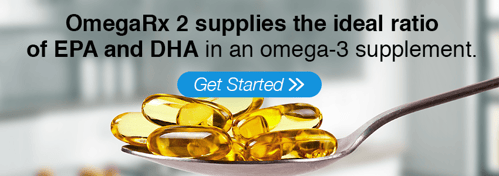Fish oils are more common in the consumer marketplace which requires individuals be more educated about what they are consuming. This isn’t as easy as you think if you don’t know what to look for. In this blog, Dr. Sears explores fish oil purity and what to know about the difference between ethyl esters and triglycerides.
The Growth of the Fish Oil Market
Before 2001 the sales of fish oil products in the United States were minimal. Prior to 2001, most of what was sold at that time consisted of the same cod liver oil that your great-grandparents gave your grandparents before they could leave the house each morning. It tasted terrible because it wasn’t purified and required having to take a tablespoon daily because it wasn’t very concentrated since it was derived from extracted cod livers. All of that changed starting in 2002, as shown by this graph taken from the Washington Post.

In 2001, I wrote extensively about this change in my book The OmegaRx Zone: The Miracle of the New High-Dose Fish Oil. I described the breakthroughs taking place in the processing of omega-3 fatty acid concentrates and how this could eventually usher in a new era of medicine. Yet less than eight percent of American adults were consuming fish oil supplements by 2012 (2).
Why Not Just Eat Fish?
Consuming fish solely as a source of omega-3 fatty acids in the diet sounds good in theory, but what is considered an acceptable level of intake? The goal should be to consume enough omega-3 fatty acids to deliver at least 2.5 grams of EPA and DHA daily. You require those levels because omega-3 fatty acids are essential nutrients the body cannot make, and the diet must supply them. If you were to translate 2.5 grams of EPA and DHA into fish consumption, that would be about 40 oz. of canned tuna or 8 oz of canned salmon daily. Unfortunately, the types of fish that Americans prefer to eat are lean fish that have minimal amounts of EPA and DHA. Furthermore, fish don’t make omega-3 fatty acids; they accumulate them from marine sources (such as plankton) that can produce them. Unfortunately, another downside to consuming large quantities of fish is that they accumulate toxins that we have thrown into the oceans, such as polychlorinated biphenyls (PCBs).
Without adequate levels of EPA and DHA, it is impossible to control inflammation in every organ in the body. Currently, the average American consumes about 100 mg of EPA and DHA. Unfortunately, those are deficient levels resulting in an increase in inflammation-driven diseases over the past 20 years.
How EPA and DHA are increased in fish oils
To increase the concentration of EPA and DHA found in crude fish oils and reduce the PCBs found in all fish oils, you must convert crude fish oil into ethyl esters and then concentrate the EPA and DHA by molecular distillation. You can’t do that with the natural triglycerides found in crude fish oils that you consume eating regular fish.
Once you convert crude fish oils into a high-potency omega-3 fatty acid ethyl ester, they become exceptionally prone to oxidation. Some manufacturers reassemble the purified ethyl esters back into triglycerides. Unfortunately, this synthetic step causes increased oxidation and the repositioning of EPA and DHA from their natural position into unnatural configurations in reconstituted triglycerides. These reconstituted fish oils are essentially “Frankenstein fats” that make it difficult for the body to convert the omega-3 fatty acids into phospholipids which are the final depots for omega-3 fatty acids in the body.
What To Know When Choosing an Omega-3
Omega-3 fatty acids are essential for human health, but only if they are purified from PCBs, not oxidized, and easily converted into phospholipids for long-term storage.
Let’s start with PCBs. PCBs are never completely removed from an omega-3 fatty acid concentrate, but depending on the refining technology, they can be reduced to very low levels. At Zone Labs, we only use selected lots of crude fish oil processed to have incredibly low PCB levels. As a result, we have the most rigid standards for the upper limits of PCBs (less than two parts per billion (2 ppb) all 209 PCB isomers) for any company, including drug companies. Furthermore, we test every finished lot of our final product used by the consumer and post the results on our website.
Another major problem is oxidative stability. Any processing of crude fish oil will cause increased oxidation leading to rancidity. Rancidity is measured by a standard test known as TOTOX which measures the levels of peroxides, aldehydes, and ketones in the final product you purchase. TOTOX levels govern all edible oil trading in the world. If the TOTOX level of any oil is greater than 26 milliequivalents/kg, it is considered unsuitable for human consumption. You can also smell these oxidation products, so even the freshest fish begin to smell. As you might expect, omega-3 fatty acid concentrates are more prone to oxidation. To get around that smell problem, some manufacturers add lemon flavors to their products. This dramatically increases the TOTOX levels in the finished product that you purchase. If a fish oil product has a lemon taste and smell you can likely assume its TOTOX levels are far greater than the upper limit of 26 milliequivalents/kg, and it is not suitable for human consumption.
Safety of Ethyl Esters
Virtually all long-term clinical studies of the safety of omega-3 fatty acids have been done with ethyl esters. These ethyl esters are ultimately converted into phospholipids that can be measured in the blood (3 ). A recent study has demonstrated that the higher the omega-3 fatty acids in the phospholipids in the blood, the lower the levels of cardiovascular disease and mortality (4). This is also true of chronic kidney disease (5).
Of course, those benefits will only be obtained if the omega-3 fatty acid product quality going into the patient is suitable for human consumption. This is why we pride ourselves in having the omega-3 fatty acids products with the lowest levels of PCBs and TOTOX compared to any company worldwide, including the largest drug companies.
References
- Sears B. The OmegaRx Zone. Regan Books. New York, NY (2001)
- Clarke TC, Black LI, Stussman BJ, Barnes PM, Nahin RL. Trends in the use of complementary health approaches among adults: United States, 2002-2012. Natl Health Stat Report 2015:1-16.
- 3, Browning LM, Walker CG, Mander AP, West AL, Madden J, Gambell JM, Young S, Wang L, Jebb SA, Calder PC. Incorporation of eicosapentaenoic and docosahexaenoic acids into lipid pools when given as supplements providing doses equivalent to typical intakes of oily fish. Am J Clin Nutr. 2012 Oct;96(4):748-58. doi: 10.3945/ajcn.112.041343.
- Harris WS, Del Gobbo L, Tintle NL. The Omega-3 Index and relative risk for coronary heart disease mortality: Estimation from 10 cohort studies. Atherosclerosis. 2017 Jul;262:51-54. doi: 10.1016/j.atherosclerosis.2017.05.007.
- Ong KL, Marklund M, Huang L, Rye KA, Hui N, Pan XF et al. Association of omega 3 polyunsaturated fatty acids with incident chronic kidney disease: pooled analysis of 19 cohorts. BMJ. 2023 Jan 18;380:e072909. doi: 10.1136/bmj-2022-072909.







Let Us Know What You Thought about this Post.
Put your Comment Below.